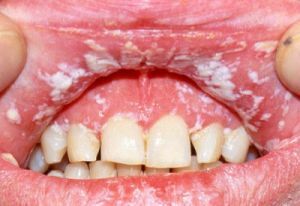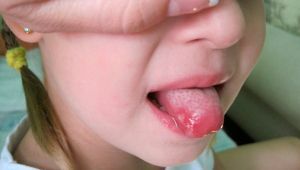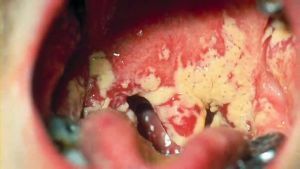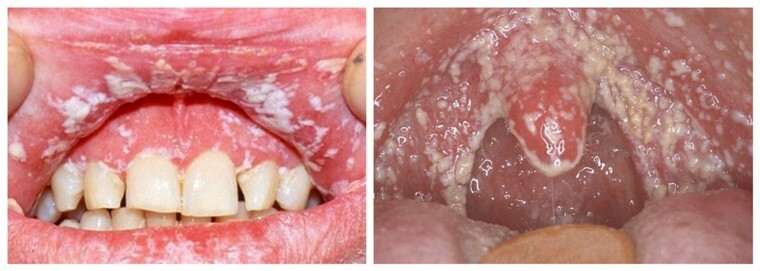 Diagnosis of infectious diseases of the oral cavity usually does not require any special dental manipulations, in addition to examining the affected areas.
Diagnosis of infectious diseases of the oral cavity usually does not require any special dental manipulations, in addition to examining the affected areas.
Despite similar external manifestations, oral infections still have pronounced distinctive features.
Contents of
- For what reasons does the infection "settle" in the mouth?
- Infectious diseases of the oral cavity, their characteristics
- HIV infection settled in the mouth
- Preventive measures and possible complications
Why is the infection "settling" in the mouth?
The most common cause of infectious infections is the lack of basic but regular hygiene procedures. However, dentists advise their patients to pay special attention to the possibility of infection in such cases:
- Pregnancy and lactation .These periods in a woman's life are characterized by a special need for adequate nutrition. Many future mothers can not deny themselves sweet food, while not completely reflect on the consequences of such taste predilections. And in vain, because sugar helps microbes destroy tooth enamel. Therefore, as preventive measures for infectious diseases, not only consultative methods are used by specialized specialists, but systematic cleaning of the oral cavity is also recommended using properly selected means.
- Allergic reactions .In some cases, the herpes virus and stomatitis can be a consequence of the allergy manifested in the
 organism. Depending on the disease, the doctor combines antihistamines and medications that affect one or another disease.
organism. Depending on the disease, the doctor combines antihistamines and medications that affect one or another disease. - Viscous saliva .Increased viscosity leads to the fact that the oral cavity creates a favorable atmosphere for fungal pathogens and harmful bacteria. In order to change the consistency of the secretion of the salivary glands, you need to see a doctor who will help determine the cause and give appropriate recommendations for treatment.
- Rumors and mechanical damage to the oral cavity .It is very important to quickly, but correctly disinfect the injured area. Thus, the infection will not receive a single chance of spreading in the oral cavity.
- Unstable emotional states and stresses .Difficult life circumstances, which get a person, weaken the body and reduce its resistance. As a result, the immune system ceases to perform a protective function and gives the infection the opportunity to spread in the most comfortable direction for it.
- General infectious diseases .Any inflammatory processes that occur in the body have a negative effect on the oral cavity. Therefore, it is necessary to select an effective treatment regimen under strict medical supervision.
- The lack of vitamins and minerals .The health of the dentoalveolar system directly depends on the quality and quantity of foods consumed by humans. The acute shortage of microelements involved in the formation and development of teeth leads to the fact that the tooth surface begins to break down. Often, in addition to a certain ratio of fruits and vegetables, the body needs additional support in the form of a vitamin complex.
Infectious diseases of the oral cavity, their characteristics
 Any infectious and inflammatory process that occurs in dental practice, can cause damage to the tooth and enamel adjacent to them. The rapid course of the disease leads to partial destruction or loss of teeth.
Any infectious and inflammatory process that occurs in dental practice, can cause damage to the tooth and enamel adjacent to them. The rapid course of the disease leads to partial destruction or loss of teeth.
Specialists identify several common types of oral infection, each of which must be neutralized in the shortest possible time:
- Gingivitis .This disease is characterized by inflammation of the gums, localized in the immediate vicinity of the base of the tooth. Painful sensations in the initial stage of gingivitis are almost not observed, however, when visual examination there is some puffiness of the area adjacent to the tooth. The absence of treatment is fraught with bleeding gums and the formation of periodontal pockets. To eliminate symptoms, doctors recommend that patients pay attention to the proper performance of hygienic manipulations and the compliance of care products with those tasks that must be resolved with their help. Professional cleaning and drug therapy are also included in the list of actions taken to restore normal flora.
- Glossite .The source of inflammation of the tongue is streptococcal infection. With glossitis, uncomfortable sensations can manifest not only during meals, but also when swallowing, as well as speech stress. Outwardly, the disease manifests itself in the form of plaque and ulcers, chaotically located on the surface of the tongue. Redness and swelling of the affected areas also indicate a pathology. In each case, the dentist selects individual treatment, but antiseptic treatment and taking pain medication help to cope with the disease most effectively.
- Periodontitis .Symptoms of periodontitis almost completely duplicate the signs of gingivitis, however, tissue damage here is somewhat more intense than with gingivitis. The inflammatory process that takes place in the gums is manifested not only by their swelling and bleeding, but also by the elevated temperature of the body, to which the mobility of the tooth can join due to the loss of bone tissue. As treatment and prophylactic measures, the dentist can use complex therapy with preliminary cleaning of enamel from tartar. Damaged tissue is excised, and the inflamed root of the tooth is partially or completely removed.

- Stomatitis .At the initial stage of the disease, a white coating forms in the oral cavity. If it is not treated, then over time the infection begins to penetrate deeper into the mucous membrane, on the surface of which there are wounds, ulcers and purulent formations. The doctor determines the type of stomatitis and, in accordance with it, selects the remedies for treatment. It can be as antiseptic preparations, and infusions of grasses, and also ointments and solutions for irrigation.
- Herpes .Most often the occurrence of herpes is preceded by a decrease in the protective functions of the body. Primary signs of the disease are almost invisible, so patients pay attention to their health after the formation of pimples and painful sores. In the fight against herpes, you can win using complex therapy, alternating antiviral drugs with antiseptic drugs.
HIV infection has settled in the mouth
The human immunodeficiency virus affects the immune system and, unfortunately, no country has yet developed drugs for its treatment.
However, with timely access to a doctor, the symptoms of this disease quite successfully stop. In most cases, the mucosa of an HIV-infected person is affected by candidiasis stomatitis, which spreads throughout the oral cavity. White coating can be located not only on the inside of the cheeks, but also on the tongue.
When external examination of the patient often observed wounds, which eventually transformed into ulcers and erosive indentations. Simple and herpes zoster provides a lot of discomfort when eating.
The lesion of the skin with papillomavirus also does not pass asymptomatically. Nodules formed in the oral cavity cover not only the palate, but also the gums.

Candidiasis - the main manifestation of HIV infection in the oral cavity
Preventive measures and possible complications
Having trusted their health professionals, it is enough to rely on their experience and fulfill all the recommendations prescribed by them. High-quality hygiene procedures, regular visits to the dental office, including not only examination, but also professional cleaning with the use of various modern technologies, as well as individual selection of drugs that support the optimal balance of vitamins in the body, will help to cope with the infection in the mouth at the initial stage of itmanifestations.
Non-treated inflammatory processes from the oral cavity can spread throughout the body, affecting the respiratory system and digestive system. It is not easy to recover from such complications, so complete recovery comes only after revealing all the provoking factors.
